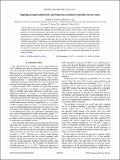Topological superconductivity and Majorana fermions in metallic surface states
Author(s)
Potter, Andrew Cole; Lee, Patrick A.
DownloadPotter-2012-Topological superconductivity and Majorana fermions in metallic surface states.pdf (605.7Kb)
PUBLISHER_POLICY
Publisher Policy
Article is made available in accordance with the publisher's policy and may be subject to US copyright law. Please refer to the publisher's site for terms of use.
Terms of use
Metadata
Show full item recordAbstract
Heavy metals, such as Au, Ag, and Pb, often have sharp surface states that are split by strong Rashba spin-orbit coupling. The strong spin-orbit coupling and two-dimensional nature of these surface states make them ideal platforms for realizing topological superconductivity and Majorana fermions. In this paper we further develop a proposal to realize Majorana fermions at the ends of quasi-one-dimensional metallic wires. We show how superconductivity can be induced on the metallic surface states by a combination of proximity effect, disorder, and interactions. Applying a magnetic field along the wire can drive the wire into a topologically nontrivial state with Majorana end states. Unlike the case of a perpendicular field, where the chemical potential must be fine-tuned near the Rashba band crossing, the parallel field allows one to realize Majorana fermions for an arbitrarily large chemical potential. We then show that, despite the presence of a large carrier density from the bulk metal, it is still possible to effectively control the chemical potential of the surface states by gating. The simplest version of our proposal, which involves only an Au(111) film deposited on a conventional superconductor, should be readily realizable.
Date issued
2012-03Department
Massachusetts Institute of Technology. Department of PhysicsJournal
Physical Review B
Publisher
American Physical Society
Citation
Potter, Andrew, and Patrick Lee. “Topological Superconductivity and Majorana Fermions in Metallic Surface States.” Physical Review B 85.9 (2012) : [9 pages]. ©2012 American Physical Society.
Version: Final published version
ISSN
1098-0121
1550-235X